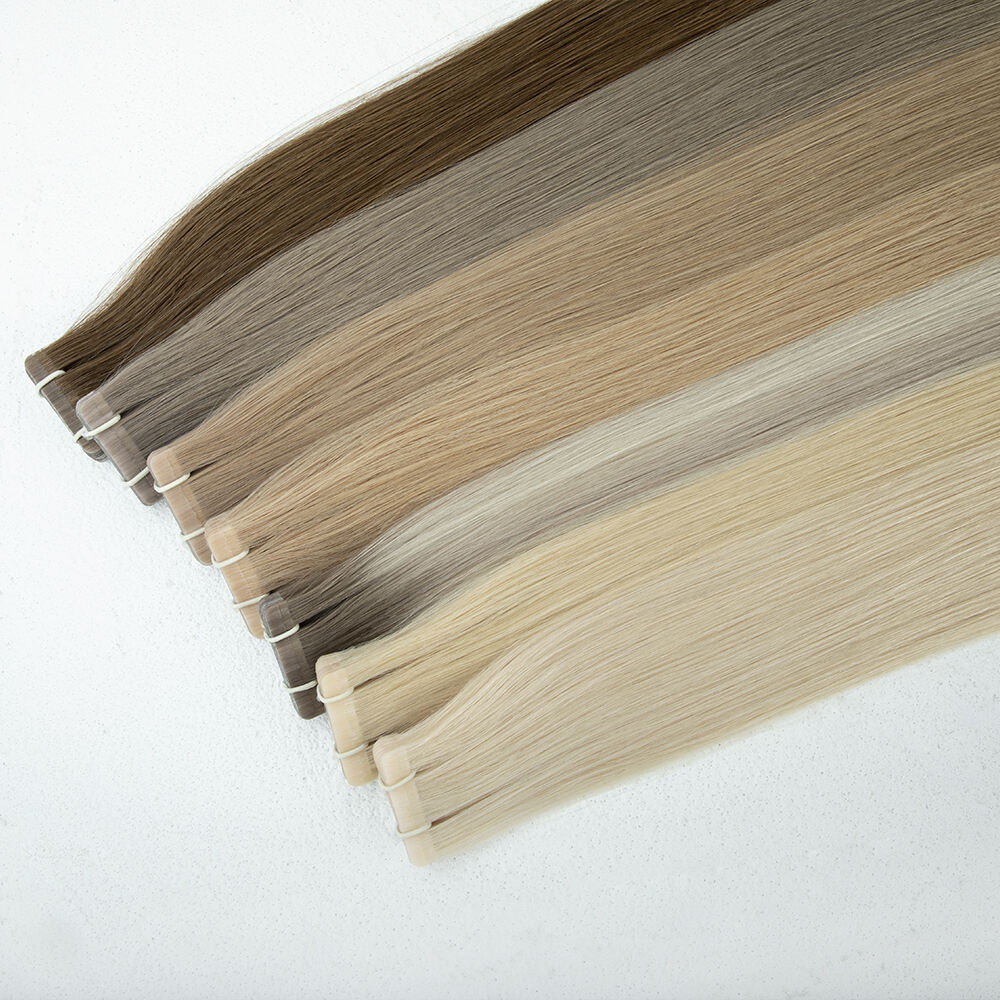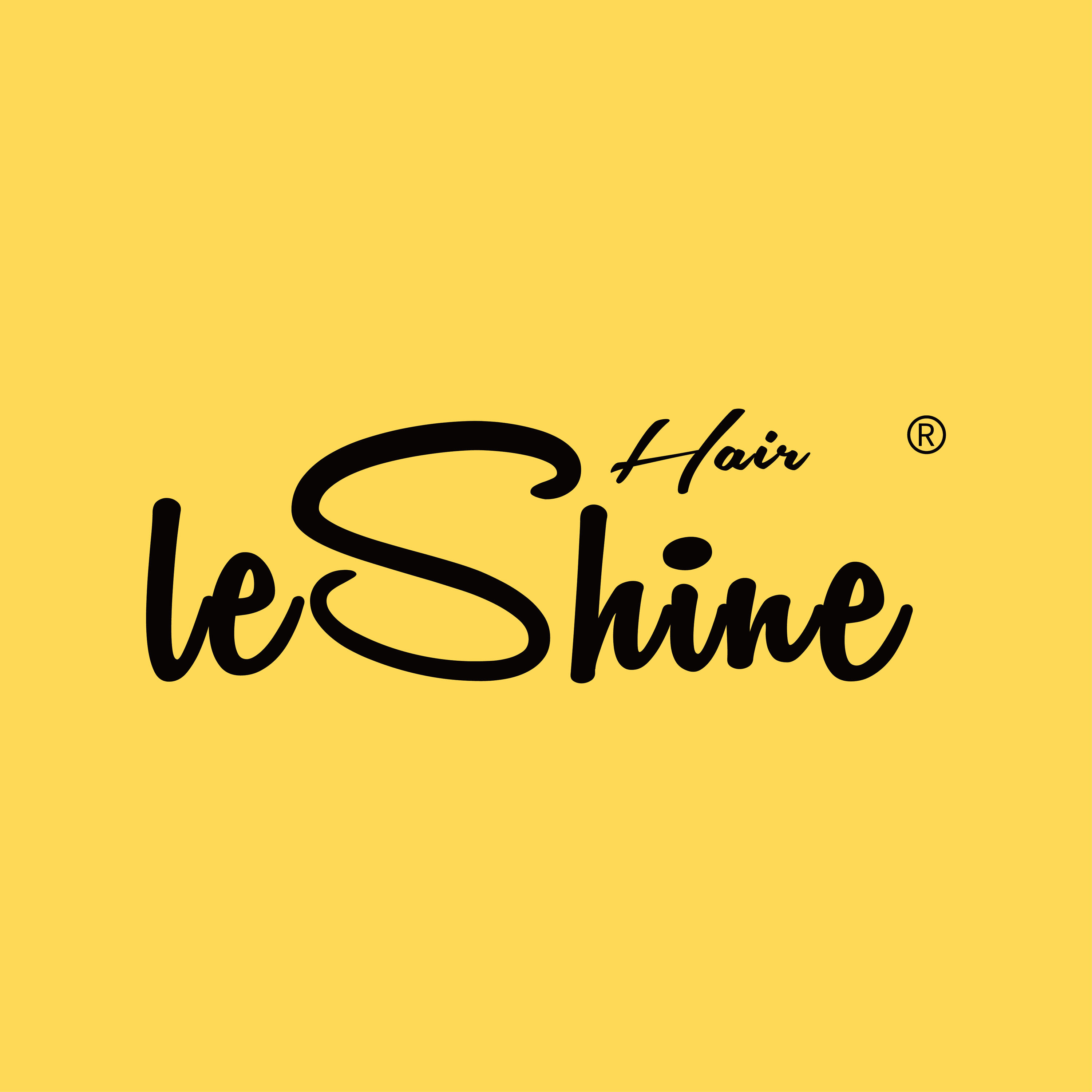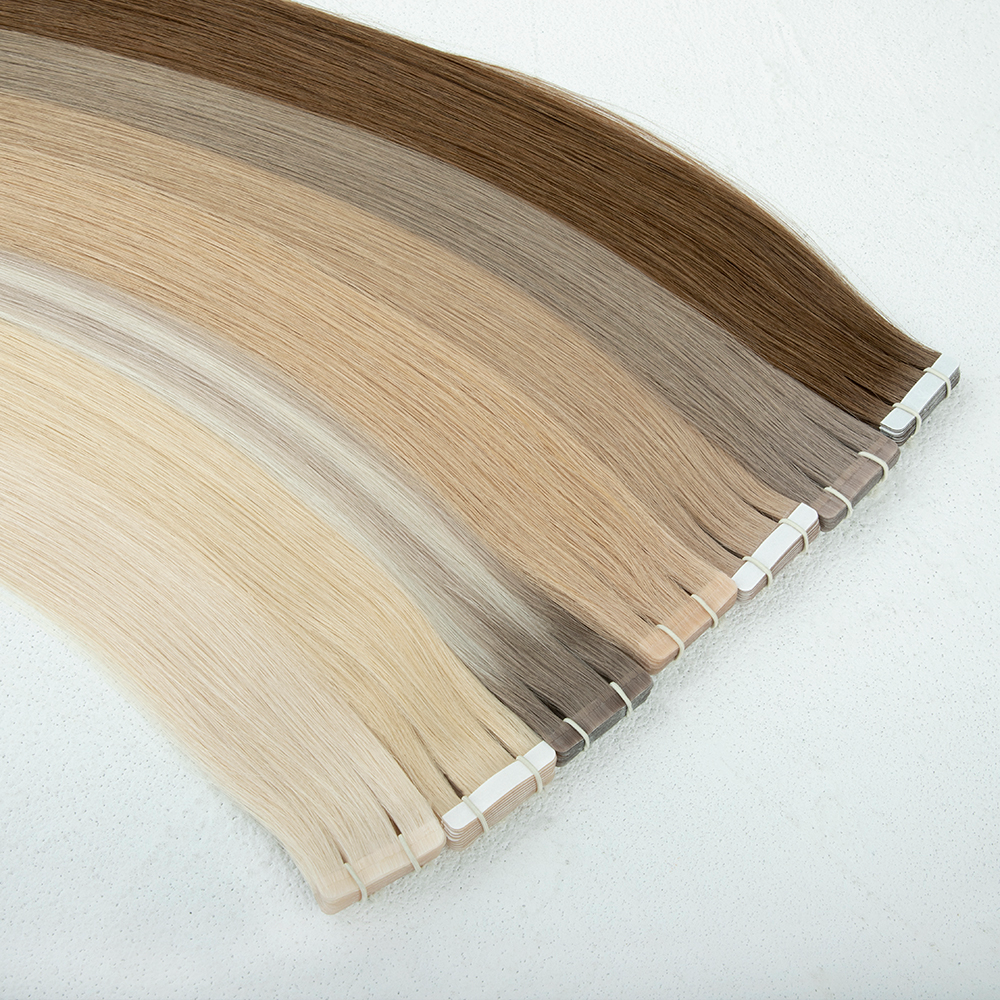
What Are Tape-In Extensions? Understanding the Basics of Human Hair Tape-Ins
How Do Tape-In Hair Extensions Work?
Tape in extensions work by sticking small pieces of real human hair onto someone's own hair using special medical grade glue strips. What happens is that a good hair stylist takes about half a centimeter or so of the client's hair and puts it right in between these little tape segments on either side. The whole thing sticks together pretty well and usually stays put for around four to six weeks according to USA Hair from last year. One nice thing about this approach is how it spreads out the weight across the head, which means less pulling on the scalp. Plus, when done right, these extensions just sort of disappear into the person's regular hairline without anyone noticing them.
The Structure and Composition of Human Hair Tape-Ins
The best quality tape-in extensions are made entirely from Remy human hair where all those little cuticle bits line up properly so they don't get tangled as easily. They attach to these flexible polyurethane strips for secure placement. Most wefts weigh somewhere between 5 and 10 grams, coming in sizes from 14 inches all the way up to 24 inches long depending on what look someone wants. What sets them apart from cheaper synthetic options is their ability to handle heat tools pretty well too. These can take temperatures around 350 degrees Fahrenheit which means people can still curl or straighten their hair without worrying about melting anything off. Companies such as Bombay Hair have developed some really good adhesive formulas that won't irritate sensitive scalps but also move naturally with the hair instead of pulling at it, which helps keep everything looking neat and prevents those annoying breakages over time.
Natural Appearance and Seamless Blend with Your Hair
This super thin adhesive tape measures just 0.2 mm thick and sits right on the head without bunching up, making it almost impossible to tell where real hair ends and extensions begin. The color matching process gets pretty close to matching those subtle tones that make each person's hair unique. For folks who want texture too, there are special versions that work for wavy or curly styles. According to a recent study from last year, nearly nine out of ten people said they couldn't spot any difference at all during office meetings or hanging out with friends, especially when someone trained properly does the application.
Key Benefits of Human Hair Tape-In Extensions
Lightweight and Comfortable for All-Day Wear
Tape-in hair extensions typically come in at under 5 grams per weft, which makes them pretty much the lightest option available for semi-permanent extensions. The flat adhesive backing sticks right against the scalp so there's no bulging from clips or bonding agents that can irritate the skin after wearing them all day. When compared to heavier styles such as sewn-in weaves, these tape ins spread out the weight much better throughout the entire head. This even distribution cuts down on strain for natural hair roots by around two thirds when measured against older techniques according to industry data from Private Label Extensions.
Minimal Damage to Natural Hair with Proper Application
Tape-in extensions actually cause very little breakage when put in right by someone who knows what they're doing. Good stylists will section the hair carefully so they don't mess up the natural structure. The special glue sticks to just a tiny bit of each strand, about 1 or 2 millimeters, and doesn't overlap anywhere. This lets the real hair keep growing normally underneath. Some research from last year showed something interesting too. When tape-ins are done correctly, they hurt about 22% fewer hairs compared to those clip-in types after around half a year. Makes sense really since the clips can tug at the roots more over time.
Styling Versatility: Heat, Color, and Everyday Looks
Human hair tape-ins offer unmatched adaptability:
- Withstand heat styling up to 350°F for curls, straightening, or blowouts
- Can be professionally colored 2-3 shades darker/lighter to match trends
- Maintain texture through workouts, humidity, and repeated washing
Unlike synthetic options that melt under heat tools, premium human hair extensions retain cuticle alignment for salon-quality results.
Aesthetic Advantages Over Synthetic Alternatives
Human hair tape ins really do look and feel like the real deal when it comes to how they move, their natural shine, and even those tiny details at the cuticle level. Synthetic options tend to have this weird glow around them that stands out in bright light, whereas real hair just looks normal because it handles light the same way our own strands do. Most people who've tried both types notice something interesting too. According to a survey from Dhestetica Salon back in 2023, nearly 9 out of 10 customers said their synthetic extensions started looking flat and lifeless after about three weeks, while the human hair versions kept looking good for over ten weeks before needing attention.
Quality, Durability, and Longevity of Human Hair Tape-Ins
How Long Do Tape-In Extensions Last? (4–6 Weeks Per Application)
Tape-in extensions human hair offer semi-permanent wear, lasting 4–6 weeks per application according to most stylists. This timeframe balances hair growth cycles with adhesive integrity – shifting natural roots require repositioning to maintain seamless blending. Temporary removal preserves hair health by preventing excessive tension as strands grow.
Reusability with Proper Care and Maintenance
Quality tape-ins shine in long-term value:
- 3+ reapplications with fresh adhesive tabs
- Sulfate-free washing to prevent tape degradation
-
Gentle brushing from ends to roots
A proper maintenance schedule extends lifespan to 4-6 months, outperforming single-use synthetic options.
Real Human Hair vs. Synthetic: Why Quality Matters
Authentic human hair withstands 450°F heat styling and color treatments—critical for matching evolving trends. Unlike plastic-based synthetics that tangle irreversibly after 8 washes (2023 Hair Industry Report), human strands maintain cuticle alignment for smooth detangling. This structural advantage explains their 67% higher satisfaction rates in multi-month wear scenarios.
Investing in Premium Extensions for Better ROI
While upfront costs run 30-50% higher than synthetic versions, medical-grade human hair tape-ins reduce replacement frequency. Over 12 months, users save $180+ through reuse cycles while avoiding damage repair treatments ($95 per session average). Premium keratin-rich hair also accepts toners and glosses flawlessly, adapting to seasonal color changes without replacement.
Professional Application Process for Flawless Results
Human hair tape-in extensions require meticulous application to achieve natural-looking results. Unlike clip-ins or glue-based methods, tape-ins rely on medical-grade adhesive tabs that bond extensions to small sections of your natural hair.
Step-by-Step Guide to Applying Tape-In Extensions
Professionals start by sectioning clean, dry hair and trimming any split ends. They sandwich ½-inch sections of natural hair between two extension wefts, ensuring the adhesive tabs align perfectly. Heat-activated tools gently press the tabs for secure bonding without damaging strands.
Choosing the Right Color, Texture, Length, and Volume
Opt for extensions that mirror your hair’s undertones and density. For example, silky straight extensions blend poorly with coarse curls. Stylists use color-matching swatches and texture tests to avoid visible seams—a critical step 68% of DIY users overlook, according to a 2023 salon industry survey.
Avoiding Common DIY Mistakes and When to See a Pro
At-home kits often lead to uneven placement, premature slippage, or traction alopecia from excessive tension. If extensions feel tight or cause scalp irritation, consult a stylist immediately to prevent follicle damage.
Salon Expertise vs. At-Home Kits: Weighing the Options
While DIY kits cost $50–$120 upfront, salon applications last 30–50% longer due to precision placement and salon-grade adhesives. Professionals also customize weft distribution to avoid strain on fine hair—a key advantage for 79% of users in a 2023 client satisfaction report.
Maintenance and Care Tips to Extend Lifespan of Human Hair Tape-Ins
Daily Care: Washing, Brushing, and Sleeping Tips
Preserving human hair tape-in extensions requires a gentle approach. Most people find washing their hair about 2 to 3 times per week works best when using sulfate free shampoos since regular ones can break down the adhesive over time. When brushing, start at the ends and work upwards with a soft bristle brush, being careful not to pull too hard on those little tape sections. Before bed, it's smart to tuck hair into something loose like a braid or bun, especially if sleeping on silk pillowcases helps reduce friction and keeps everything from getting all tangled. Too much washing or aggressive towel drying will wear out those tapes faster than we'd like, so blotting dry tends to be the better option for longer lasting results.
Maintaining Tape Integrity and Preventing Slippage
Stay away from oil based products around where the tape is bonded since oils tend to break down adhesives eventually. When using a blow dryer, try to keep it at least a good distance away from the root area. Sometimes when we have to style close to the scalp, putting on some kind of heat protection spray makes all the difference. During exercise sessions, tying hair back in a low ponytail helps cut down on sweat build up that can really mess with how well things stick together.
Solving Common Issues: Matting, Visibility, and Irritation
| Issue | Solution |
|---|---|
| Matting | Apply a pea-sized amount of silicone-free leave-in conditioner to mid-lengths. |
| Visible Tapes | Ensure proper placement during reapplication—tapes should lie flat against the scalp. |
| Scalp Irritation | Switch to alcohol-free styling products and avoid heavy buildup near bonds. |
Re-Taping and Storage for Reuse Between Applications
Re-tape extensions every 6–8 weeks using professional-grade adhesive strips to maintain grip strength. After removal, clean residual glue with rubbing alcohol, then store strands in a breathable pouch away from humidity. For optimal reuse, avoid folding or compressing the hair during storage.
Proper care extends the lifespan of high-quality human hair tape-in extensions, allowing 3–4 reapplications before replacement. By prioritizing gentle handling and professional maintenance, you’ll protect both your natural hair and your investment.
FAQ Section
What are tape-in hair extensions made of?
Tape-in hair extensions are typically made of 100% Remy human hair, securely attached to flexible polyurethane strips using medical-grade adhesive.
How long do tape-in extensions last per application?
They last around 4 to 6 weeks per application, depending on individual hair growth cycles and adhesive quality.
Can tape-in extensions be reused?
Yes, quality tape-in extensions can be reused up to 3 times with proper care and maintenance, depending on the condition of the adhesive strips.
What precautions should I take to maintain tape-ins?
Use sulfate-free shampoos, avoid oil-based products near the bonds, and re-tape every 6 to 8 weeks. Gentle handling and professional maintenance will extend their lifespan.
Should tape-in extensions be professionally applied?
Yes, it's recommended to have them applied by professionals for best results, avoiding common DIY mistakes such as uneven placement and tension damage.
Table of Contents
- What Are Tape-In Extensions? Understanding the Basics of Human Hair Tape-Ins
- Key Benefits of Human Hair Tape-In Extensions
- Quality, Durability, and Longevity of Human Hair Tape-Ins
- Professional Application Process for Flawless Results
- Maintenance and Care Tips to Extend Lifespan of Human Hair Tape-Ins
- FAQ Section




